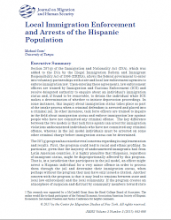Local Immigration Enforcement and Arrests of the Hispanic Population
The enforcement of immigration in the United States has traditionally fallen under the jurisdiction of the federal government. Over time, however, state and local law enforcement have taken a larger role in immigration enforcement, largely at the urging of the federal government. Federal programs such as the Criminal Alien Program (CAP), the Secure Communities program and the 287(g) program are all designed to help local agencies identify members of immigrant communities for detention and deportation. This study explores the effects of implementation of the 287(g) program in Frederick County, Maryland. Using data from individual arrest records from the Frederick County Sheriff's Office, which has a 287(g) agreement with ICE, and the Frederick Police Department, which does not, the study analyzed the changes in arrests between the two agencies before and after the 287(g) program was implemented in 2008. The author found that overall the arrests of Hispanics fell, suggesting that the Hispanic community avoided interaction with law enforcement when the program began. However, the program also led to a significantly higher number of arrests of Hispanics by the Sheriff's Office than would have occurred in its absence, indicating that attention was focused toward the Hispanic community as a result of the program. These results suggest that, if the program is to continue, additional safeguards are needed to prevent abuses and civil rights violations. (Jonathan Eizyk for The Immigrant Learning Center's Public Education Institute)
Coon, M. (2017). Local Immigration Enforcement and Arrests of the Hispanic Population. Journal on Migration and Human Security, 5(3), 645–665. https://doi.org/10.14240/jmhs.v5i3.102

